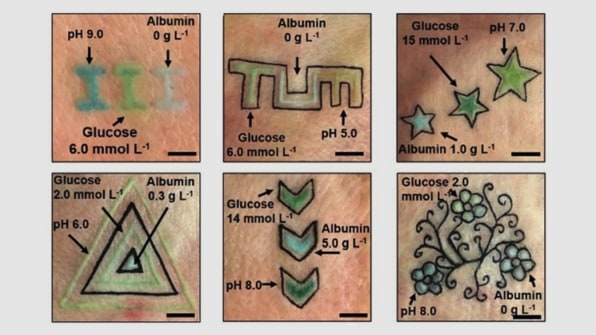Get one of these tattoos, and you get real-time updates on your health status
People have been tattooing themselves for more than 5,000 years. In the past, tattoos have been used to indicate a person’s status or, more recently, aesthetic preferences. But now, they could be a way for people with serious health issues, such as diabetes or kidney disease, to track their conditions in real time.
A team of scientists at the Technical University of Munich in Germany developed a way to tattoo the skin with a fluid that changes color as certain properties in the blood spike or decline.
This fluid is made up of different dyes that react with elements of a person’s metabolic system. The Technical University team tested three of those elements: pH levels, glucose, and albumin, which is a type of protein found in the blood. They injected the different dyes into patches of pig skin (which tattoo artists commonly practice on) and chemically adjusted concentrations of the three biomarkers. The tattoos changed colors as the concentrations of pH, glucose, and albumin shifted. To evaluate these changes, the researchers developed an app that detected the color of the tattoo and gave a reading of what possible heath concerns it might indicate.
According to the study, published in Angewandte Chemie International Edition, the Technical University researchers believe that applying these color-shifting tattoos to patients whose health conditions must be monitored by measuring levels of these elements could be a low-cost way to offer them a consistent way to track their health.

Each of the elements measured tracks with specific health concerns. Changes in a person’s pH levels could indicate a range of issues, particularly with the lungs and kidneys, which help regulate blood acidity. As pH levels rose from five to nine (normal human pH levels are around 7.4), the tattoo ink shifted from yellow to blue. If a person tattooed with this ink, for instance, noticed their dermal artwork was turning yellow, they’d know their blood acidity was too low, and on the flip side, if it appeared dark blue, they’d know it was too high.
The glucose-detecting ink shifted from light green to dark green as concentrations of glucose increased. High blood glucose levels could indicate diabetes, which inhibits the body’s ability to metabolize sugars, so a person with diabetes could be clued in to if they’re experiencing a dangerous spike by the color of their tattoo.
To detect levels of albumin, the research team applied a dye that shifts from yellow (indicating low albumin) to green (indicating higher levels). Low albumin levels could signal liver or kidney failure or conditions like Crohn’s or celiac disease, which limit the body’s ability to absorb protein.
The changes in the tattoo ink are not diagnoses in and of themselves, but rather a potential way for a patient with longstanding health concerns to keep an eye on their condition in a relatively low-maintenance way. The idea is still new and preliminary, but the Technical University team will continue to study the feasibility of this dermal monitoring system—and perhaps the line between medical offices and tattoo parlors will one day begin to blur.
(17)



